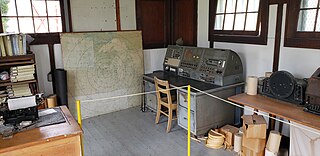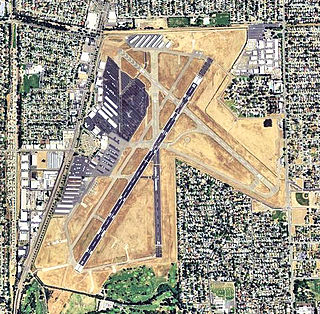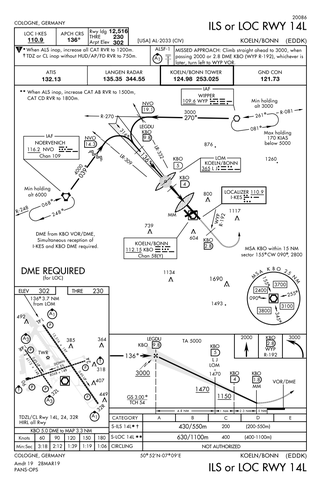Related Research Articles

Air traffic control (ATC) is a service provided by ground-based air traffic controllers (people) who direct aircraft on the ground and through a given section of controlled airspace, and can provide advisory services to aircraft in non-controlled airspace. The primary purpose of ATC worldwide is to prevent collisions, organise and expedite the flow of traffic in the air, and provide information and other support for pilots.

According to the International Civil Aviation Organization (ICAO), a runway is a "defined rectangular area on a land aerodrome prepared for the landing and takeoff of aircraft". Runways may be a human-made surface or a natural surface. Runways, taxiways and ramps, are sometimes referred to as "tarmac", though very few runways are built using tarmac. Takeoff and landing areas defined on the surface of water for seaplanes are generally referred to as waterways. Runway lengths are now commonly given in meters worldwide, except in North America where feet are commonly used.
Aviation is the design, development, production, operation, and use of aircraft, especially heavier-than-air aircraft. Articles related to aviation include:
Airspace is the portion of the atmosphere controlled by a country above its territory, including its territorial waters or, more generally, any specific three-dimensional portion of the atmosphere. It is not the same as outer space which is the expanse or space outside the Earth and aerospace which is the general term for Earth's atmosphere and the outer space within the planet's vicinity.

METAR is a format for reporting weather information. A METAR weather report is predominantly used by aircraft pilots, and by meteorologists, who use aggregated METAR information to assist in weather forecasting. Today, according to the advancement of technology in civil aviation, the METAR is sent as IWXXM model.
Automatic terminal information service, or ATIS, is a continuous broadcast of recorded aeronautical information in busier terminal areas. ATIS broadcasts contain essential information, such as current weather information, active runways, available approaches, and any other information required by the pilots, such as important NOTAMs. Pilots usually listen to an available ATIS broadcast before contacting the local control unit, which reduces the controllers' workload and relieves frequency congestion. ATIS was developed and adopted by the FAA in the mid-1960s and internationally beginning in 1974. Before the adoption of ATIS, this information was routinely disseminated to each aircraft separately, increasing controller workload during periods of high traffic density.
The world's navigable airspace is divided into three-dimensional segments, each of which is assigned to a specific class. Most nations adhere to the classification specified by the International Civil Aviation Organization (ICAO) and described below, though they might use only some of the classes defined below, and significantly alter the exact rules and requirements. Similarly, individual nations may also designate special use airspace (SUA) with further rules for reasons of national security or safety.

A flight service station (FSS) is an air traffic facility that provides information and services to aircraft pilots before, during, and after flights, but unlike air traffic control (ATC), is not responsible for giving instructions or clearances or providing separation. They do, however, relay clearances from ATC for departure or approaches. The people who communicate with pilots from an FSS are referred to as flight service specialists.

Troutdale Airport, also known as Troutdale-Portland Airport, is a corporate, general aviation and flight-training airport serving the city of Troutdale, in Multnomah County, Oregon, United States. It is one of three airports in the Portland metropolitan area owned and operated by the Port of Portland. Troutdale Airport was established in 1920 as a private airfield, then purchased by the Port of Portland in 1942. It serves as a reliever airport for nearby Portland International Airport (PDX).

The Canada Flight Supplement (CFS) is a joint civil/military publication and is a supplement of the Aeronautical Information Publication. It is the nation's official airport directory. It contains information on all registered Canadian and certain Atlantic aerodromes and certified airports.

Paphos International Airport is a joint civil-military public airport located 6.5 kilometres south-east of the city of Paphos on the Mediterranean island of Cyprus. It is the country's second largest airport, after Larnaca International Airport. Paphos Airport is commonly used by tourists on vacation in western Cyprus, providing access to popular resorts such as Coral Bay, Limassol, and Paphos itself.

The Airports Authority of India (AAI) is a statutory body under the ownership of the Ministry of Civil Aviation, Government of India. It is responsible for creating, upgrading, maintaining, and managing civil aviation infrastructure in India. It provides Communication Navigation Surveillance/Air Traffic Management (CNS/ATM) services over the Indian airspace and adjoining oceanic areas. AAI currently manages a total of 137 airports, including 34 international airports, 10 Customs Airports, 81 domestic airports, and 23 Civil enclaves at Defence airfields. AAI also has ground installations at all airports and 25 other locations to ensure the safety of aircraft operations. AAI covers all major air routes over the Indian landmass via 29 Radar installations at 11 locations along with 700 VOR/DVOR installations co-located with Distance Measuring Equipment (DME). 52 runways are provided with Instrument landing system (ILS) installations with Night Landing Facilities at most of these airports and an Automatic Message Switching System at 15 Airports.

The airport apron, apron, flight line, or ramp is the area of an airport where aircraft are parked, unloaded or loaded, refueled, boarded, or maintained. Although the use of the apron is covered by regulations, such as lighting on vehicles, it is typically more accessible to users than the runway or taxiway. However, the apron is not usually open to the general public, and a permit may be required to gain access. An apron's designated areas for aircraft parking are called aircraft stands.

Perth Airport is a general-aviation airport located at New Scone, 3 nautical miles northeast of Perth, Scotland. The airport is used by private and business aircraft, and for pilot training. There are no commercial scheduled flights from the airport.

Sacramento Executive Airport is a public airport three miles (5 km) south of downtown Sacramento, in Sacramento County, California, United States. The airport covers 540 acres (219 ha) and has two lit runways and a helipad.

Approach plates are the printed or digital charts of instrument approach procedures that pilots use to fly instrument approaches during instrument flight rules (IFR) operations. Each country maintains its own instrument approach procedures according to International Civil Aviation Organization (ICAO) standards.

Automatic Dependent Surveillance–Broadcast (ADS-B) is an aviation surveillance technology and form of Electronic Conspicuity in which an aircraft determines its position via satellite navigation or other sensors and periodically broadcasts its position and other related data, enabling it to be tracked. The information can be received by air traffic control ground-based or satellite-based receivers as a replacement for secondary surveillance radar (SSR). Unlike SSR, ADS-B does not require an interrogation signal from the ground or from other aircraft to activate its transmissions. ADS-B can also receive point-to-point by other nearby equipped "ADS-B In" equipped aircraft to provide traffic situational awareness and support self-separation. ADS-B is "automatic" in that it requires no pilot or external input to trigger its transmissions. It is "dependent" in that it depends on data from the aircraft's navigation system to provide the transmitted data.
AirNav.com is a privately owned website for pilots and aviation enthusiasts. The site publishes aeronautical and airport information released by the Federal Aviation Administration (FAA) such as runway distances, airfield traffic patterns, airport frequencies, airport operations, facilities and services, chart location, navigational coordinates and locations, radio aids, ownership information and other pertinent information that all pilots need when traveling into or out of an airport or around the United States National Airspace System (NAS). The same information is published in the Airport/Facility Directory (A/FD), updated every 56 days.

On July 7, 2017, an Airbus A320-211 operating as Air Canada Flight 759 was nearly involved in an accident at San Francisco International Airport in San Mateo County, California, United States. The flight, which originated at Toronto Pearson International Airport, had been cleared by air traffic control to land on runway 28R and was on final approach to land on that runway; however, instead of lining up with the runway, the aircraft had lined up with the parallel taxiway, on which four fully loaded and fueled passenger airplanes were stopped awaiting takeoff clearance. The flight crew initiated a go-around prior to landing, after which it landed on 28R without further incident. The aircraft on the taxiway departed for their intended destinations without further incident. The subsequent investigation by the National Transportation Safety Board (NTSB) determined that the Air Canada airplane descended to 59 feet (18 m) above the ground before it began its climb, and that it missed colliding with one of the aircraft on the taxiway by 14 feet (4.3 m).
This is a glossary of acronyms, initialisms and terms used for gliding and soaring. This is a specialized subset of broader aviation, aerospace, and aeronautical terminology. Additional definitions can be found in the FAA Glider Flying Handbook.
References
- ↑ Wragg, David W. (1973). A Dictionary of Aviation (first ed.). Osprey. p. 203. ISBN 9780850451634.
- ↑ "Notices to Airmen". www.icao.int. Retrieved 2021-12-01.
- ↑ "FAA Order 7930.2S, Change 2, "Notices to Air Men (NOTAM)" (PDF). www.faa.gov.
- ↑ "What is a NOTAM? Notice to Airman (NOTAMs)". Federal Aviation Administration . Retrieved 12 January 2023.
- ↑ "What is a NOTAM? Notice to Air Missions (NOTAMs)". Federal Aviation Administration . Retrieved 23 January 2023.
- ↑ Chambers, Dan (February 10, 2010). "Flight School 101: What is a NOTAM?". College of Aeronautical Science & Technology. Archived from the original on December 3, 2013. Retrieved February 9, 2013.
- ↑ "Air Force Instruction Interservice Publication 11-208" (PDF).
- ↑ "Notices To Airmen", a 1921 NOTAM in Flight magazine
- ↑ "Global repository of actual NOTAMS". International Civil Aviation Organization. Retrieved 16 April 2023.
- ↑ Freed, Jamie (28 April 2021). "'Bunch of garbage': Campaign to ease pilot overload from antiquated safety warnings". Reuters. Retrieved 15 June 2022.
- 1 2 "Russia Restricts Flights Over Crimea And Black Sea". OPSGROUP. 21 April 2021.
- ↑ "Russia issues warning, restricts flight zone over Black Sea". TASS. 20 April 2021.
- ↑ "[ANALYSIS] What is Russia's actual intent in promulgating NOTAMS in the Black Sea?". Turkish Minute. 11 February 2022.
- ↑
- Zee, Mark (March 15, 2017). "The problem of Bullshit Notams". Flight Service Bureau. Archived from the original on March 16, 2017. Retrieved September 28, 2018.
{{cite web}}: CS1 maint: unfit URL (link) - "The problem of Bullshit Notams". The Opsgroup. March 2017. Retrieved 12 January 2023.
- Zee, Mark (March 15, 2017). "The problem of Bullshit Notams". Flight Service Bureau. Archived from the original on March 16, 2017. Retrieved September 28, 2018.
- ↑ "Air Force Instruction 33-115, Volume 3: Air Force Network Operating Instructions" (PDF). Air Force Departmental Publishing Office. 15 April 2004. Archived from the original (PDF) on 20 October 2012. Retrieved 11 May 2010.
- ↑ Stuart “Kipp” Lau (October 26, 2018). "AINsight: Notams Are Wall of Text and Bunch of Garbage". AIN online.
- ↑ AIM, 5–1–3 "Notice to Airmen (NOTAM) System" (August 22, 2013 revision)
- ↑ "FAA Order JO 7930.2N, Notices to Airmen (NOTAM)". 2013-10-01. Retrieved 2014-02-26.
- ↑ "FAA NOTAMS Statement". Federal Aviation Administration. 11 January 2023. Retrieved 11 January 2023.
- ↑ Freed, Jamie; Singh, Rajesh Kumar; Shepardson, David (2023-01-11). "U.S. flights beginning to resume after FAA system outage". Reuters. Retrieved 2023-01-11.